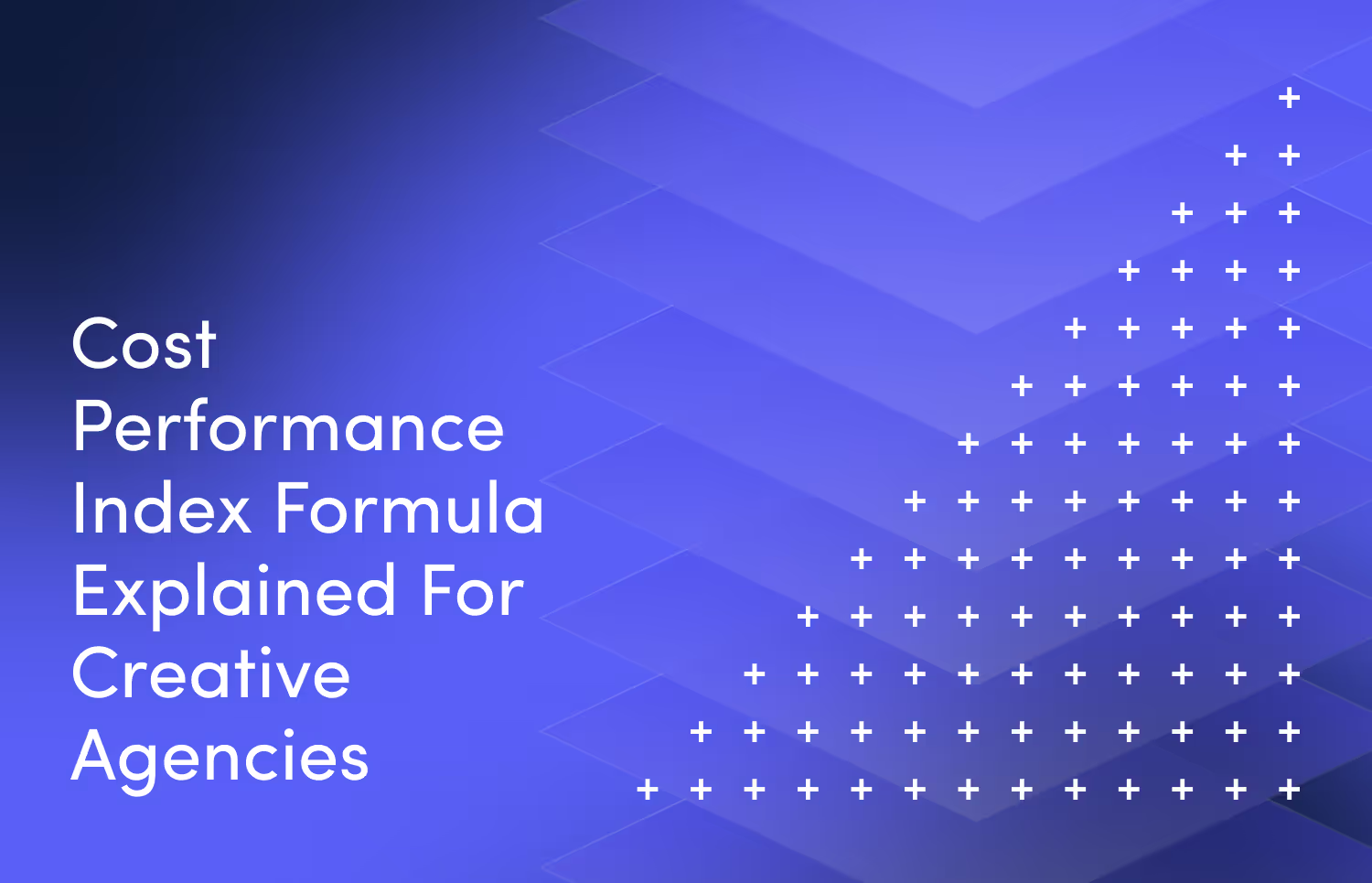Cost Performance Index Formula Explained for Creative Agencies [2025]
Learn the cost performance index formula (CPI) and how creative agencies use it to boost profits and avoid budget surprises. 📊




If you want to stay profitable, it’s a must to calculate your project's cost performance index (CPI). This single metric is your real-time intelligence that drives how you price, manage, and deliver creative work.
In this guide, we’re going to break down what CPI is, why it matters for agencies like yours, and the common mistakes of using it. (Promise: it’s a super simple formula! No need to be a math whiz!)

The Cost Performance Index (CPI) is the financial health monitor every creative agency needs. It measures how efficiently an agency spends money on a project by comparing what it has actually accomplished to what it has actually spent.
The cost performance index formula is simple: CPI = Earned Value (EV) ÷ Actual Cost (AC). (Don’t worry, we’ll break down each component later on.)
You probably came across CPI, and the usual examples are for construction or IT projects. So, here are some reasons why it also applies to your industry.
First, what is EVM? Earned Value Management (EVM) is a project management framework that helps you track a project’s health by comparing planned progress, actual progress, and actual costs.
It tracks these three essential numbers that tell you exactly where you stand:
Once you have these three numbers (PV, EV, and AC) for the reporting period in your project, EVM calculates several key performance indicators (KPIs) and variances that provide immediate insights into a project's health. CPI is one of the most critical.
Now let’s bring back the dead simple cost performance index formula:
CPI = Earned Value (EV) / Actual Cost (AC)
From our understanding of earned value management, you already know the formula’s two components.
As a measure of project performance, Earned Value (EV) is the budgeted cost of the work actually completed at a specific time. It's the value of the physical progress made, expressed in terms of the project's budget. It tells your value output compared to your budget and the actual progress of your project in monetary terms.
Project-wise, Actual Cost (AC) represents the total money truly spent or incurred to complete the work. This includes labor costs (hours × hourly rates) and other direct expenses (stock photos, fonts, travel). It's the amount spent (or owed) for the project's activities.
The magic happens when you compare these numbers in the CPI project management. The ratio reveals your efficiency.
Meaning: Your cost efficiency is perfect—but as mentioned, this is rare in creative work. For every dollar you’ve spent, you earned exactly a dollar's worth of value in completed work. Your estimates were accurate, your team is working effectively, and there's minimal waste or scope creep.
Meaning: You're getting more value for your money. For every dollar spent, you've earned more than a dollar's worth of value. Your project is running more efficiently than planned. This could be due to excellent project management and scope control, productive team members completing tasks faster than estimated, and even initial estimates being overly conservative.
Meaning: You're less efficient, spending more money than the value you're getting in return. For every dollar spent, you've earned less than a dollar's worth of value. This is your red flag. Your project is running less efficiently than planned from a cost perspective.
Now, let’s use the cost performance index formula and interpretation in a creative agency-specific example. Let's walk you through a common scenario.
Now, let's calculate the CPI:
CPI = AC/EV = $24,200/$22,000
CPI = 0.91
Interpretation: A CPI of 0.91 is a clear warning sign. For every dollar you've spent ($24,200), you've only earned back $0.91 worth of value ($22,000). So, you're 9% over budget on the work you've actually completed.
Cost performance index is a tool in the complex world of agency budgeting and financial forecasting. Hence, this is where CPI takes the spotlight.
Most agencies realize they're over budget when they get the final invoice from a freelancer, or when the hours report for the last month is double what they expected. By then, it's too late. The damage is done, and you're eating the cost.
CPI changes that. Because it measures your efficiency in real-time, a CPI consistently below 1 tells you to have a preventative approach to budget overruns.
Start presenting facts. CPI transforms difficult client conversations from defensive explanations into professional project management discussions. Your client reports turn from subjective status updates (We're running a bit over budget.) into objective financial insights (Current CPI of 0.85 indicates we're tracking 15% less efficient than planned).
🔥 Pro Tip: When clients request scope additions, CPI provides objective impact analysis.
A financially healthy project allows you to do your best work without compromising quality, and it directly contributes to client satisfaction. Truth is, your client’s satisfaction is tied to how in-control their budget feels.
CPI is powerful, but only if used correctly. So, here are the common mistakes agencies are using it wrong and how to avoid them.
If you only calculate the cost performance index at the very end of a project, or only when you suspect a problem—you've already missed its primary benefit.
So, make CPI calculation a mandatory part of your weekly or bi-weekly project review meetings. It should be as routine as checking your email. Leverage project management software that integrates time tracking and budget allocation.
As we discussed in CPI project management, EV is the value of completed work, not just money spent. AC is all actual costs, not just billable hours. Getting these wrong renders your CPI useless.
Spreadsheets are great for calculation, but not for real-time data input and aggregation across multiple projects. Trying to manually pull time sheets, expense reports, and progress updates into a spreadsheet for every CPI calculation means missed CPI updates. Better use a platform that integrates project tracking, invoicing, and financial reporting in one place—and can help automate CPI insights.
ManyRequests streamlines agency project workflows, client communication, and cost tracking—which are essential for managing project budgets and performance effectively.
Everything in one place. Client onboarding, project briefs, task assignments, communication threads, time tracking, approvals, and invoicing. When your data lives together, your Actual Costs (AC) and Earned Value (EV) calculations are clean, real-time, and actionable. No more reconciling spreadsheets every Friday.
You can build smart, conditional request forms that capture all the critical project details before work even starts. Accurate scoping is predictive agency budgeting. And predictable budgeting equals clean CPI performance.
Track every hour spent on a request or task. Assign it to a team member. Monitor how actual time compares to planned time. Since time is usually your biggest cost driver, seeing how much of your budget you’ve burned relative to work completed lets you fix overages early.
Clients can mark up designs, request changes, and approve files directly inside the platform. Streamlined feedback loops cut down on endless revision cycles and avoid scope creep—two of the biggest silent killers of project profitability (and CPI performance).
And what do all those ManyRequests functionalities add up to? Better cost control, smarter forecasting, and less scope creep.
CPI project management lets you know exactly where your money is going and what value you're getting. So, leverage tools that are built for this.
A platform like ManyRequests simplifies everything by integrating project planning, client collaboration, and time tracking—key elements for maintaining (or improving) the cost performance index throughout a project’s lifecycle.
Try ManyRequests for free and see how it can transform your agency's profitability.